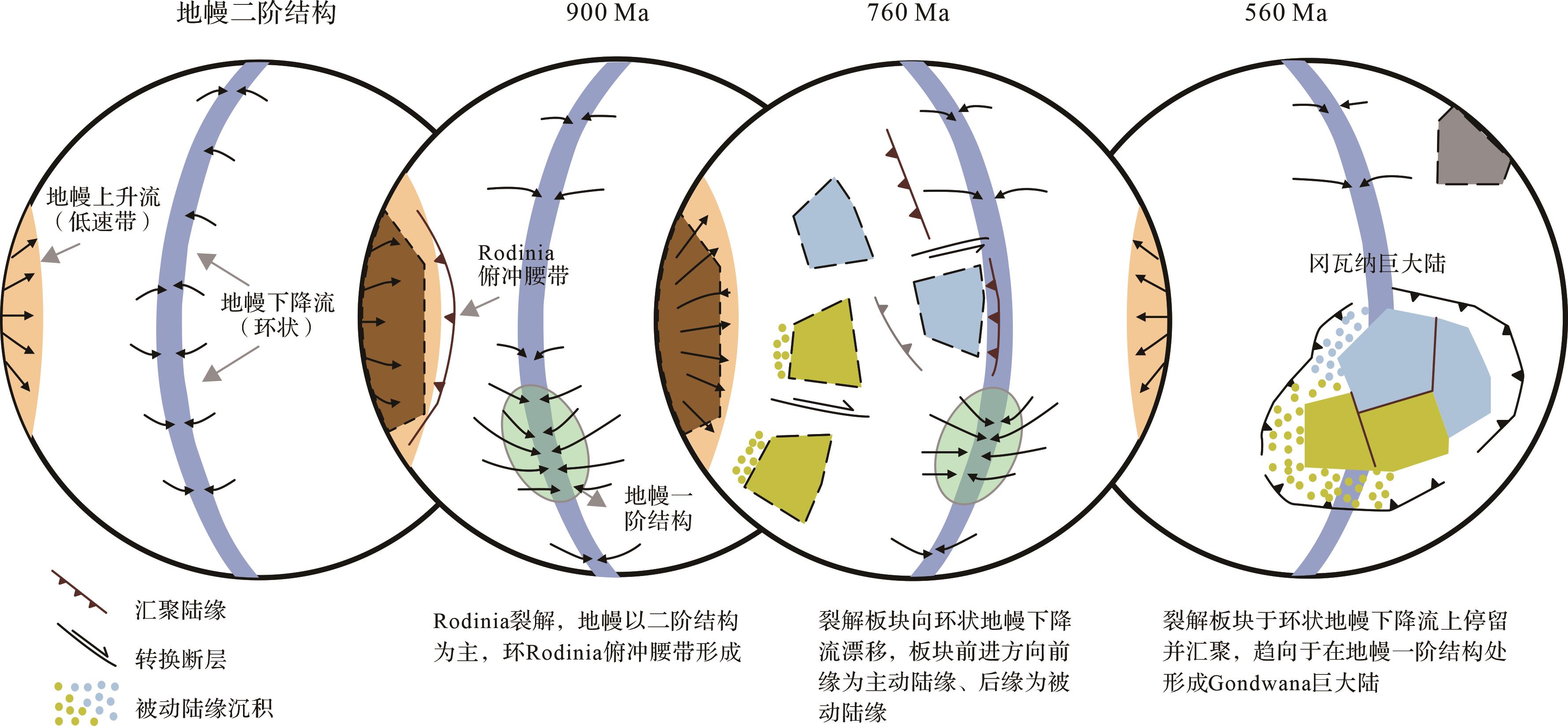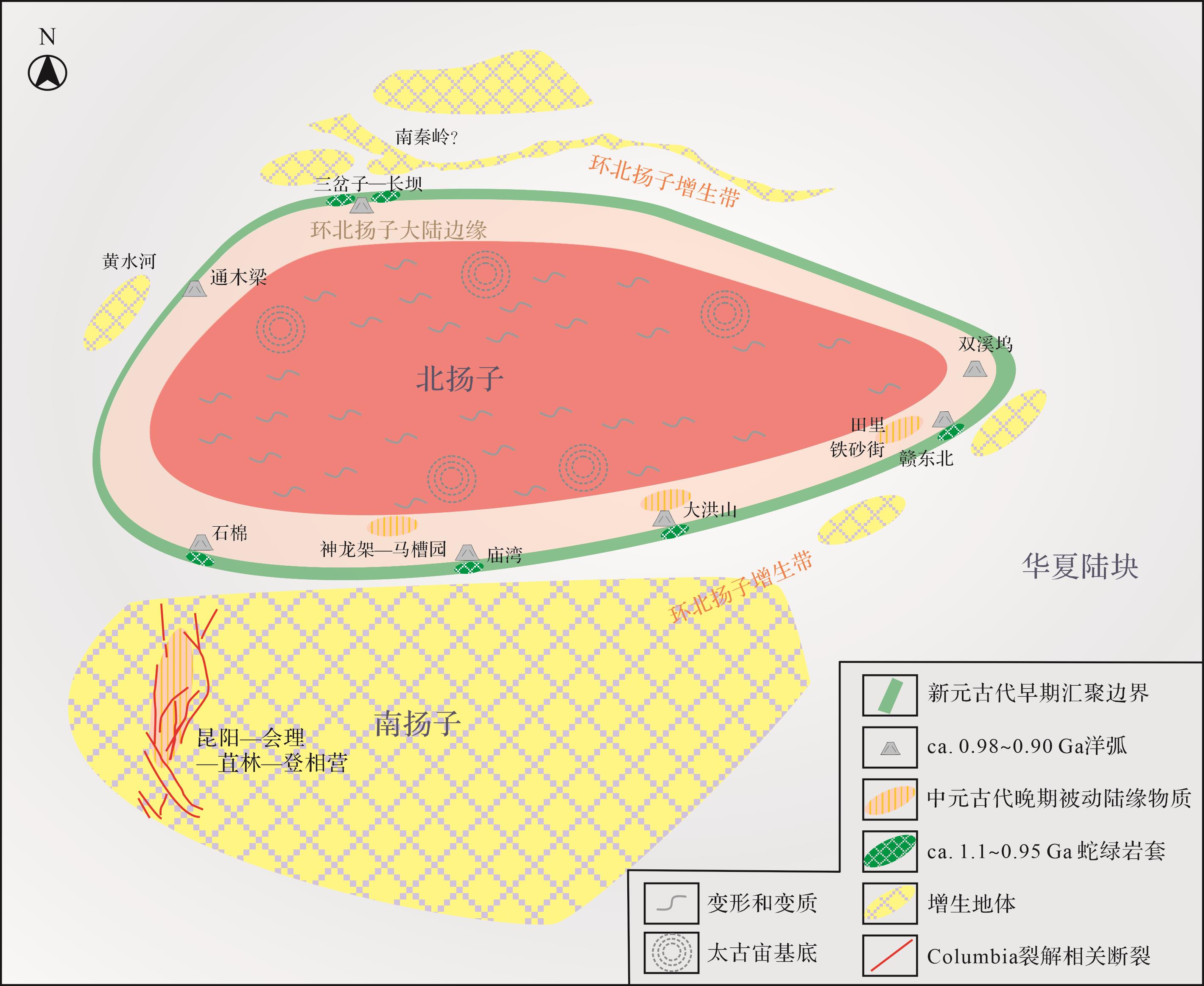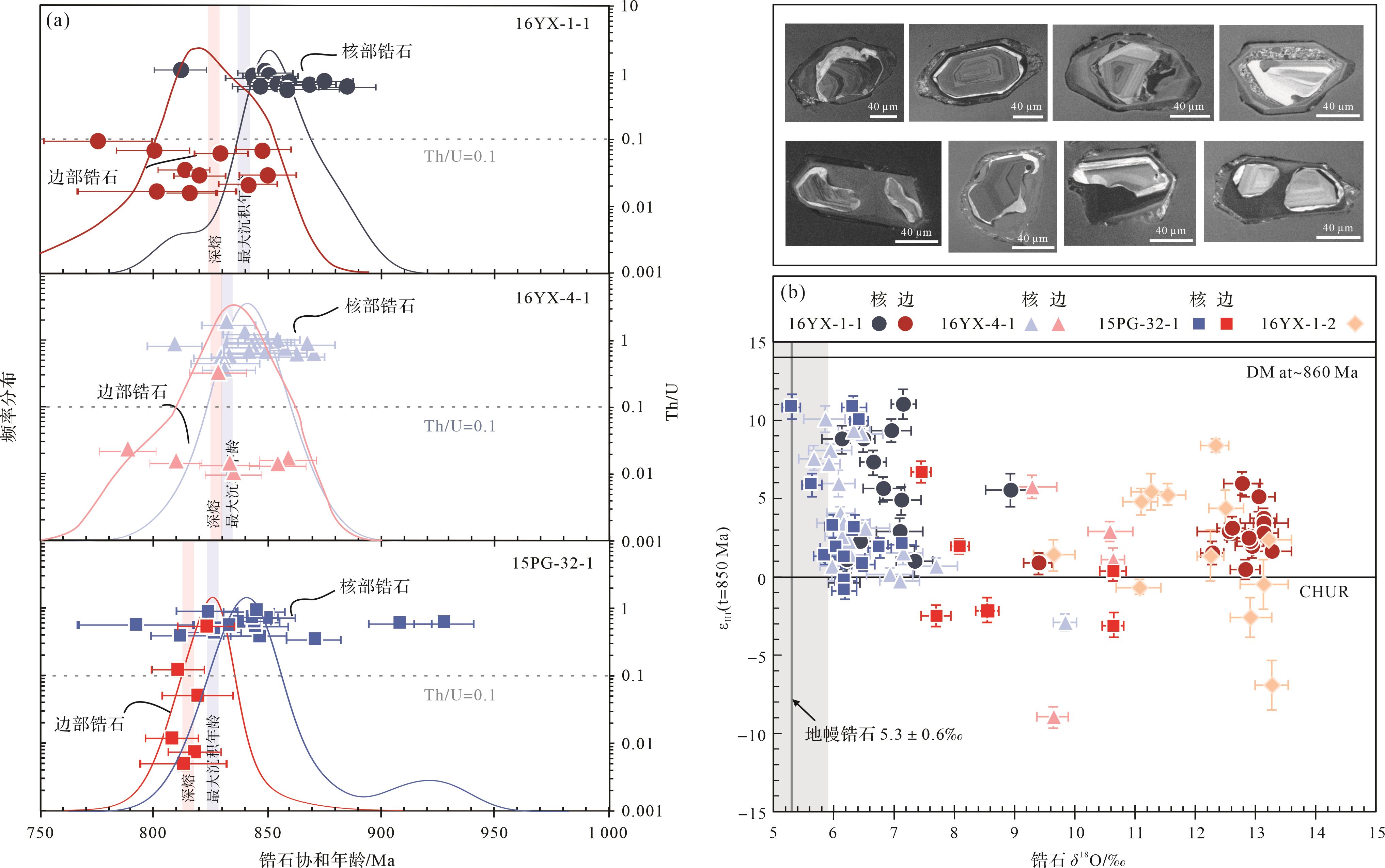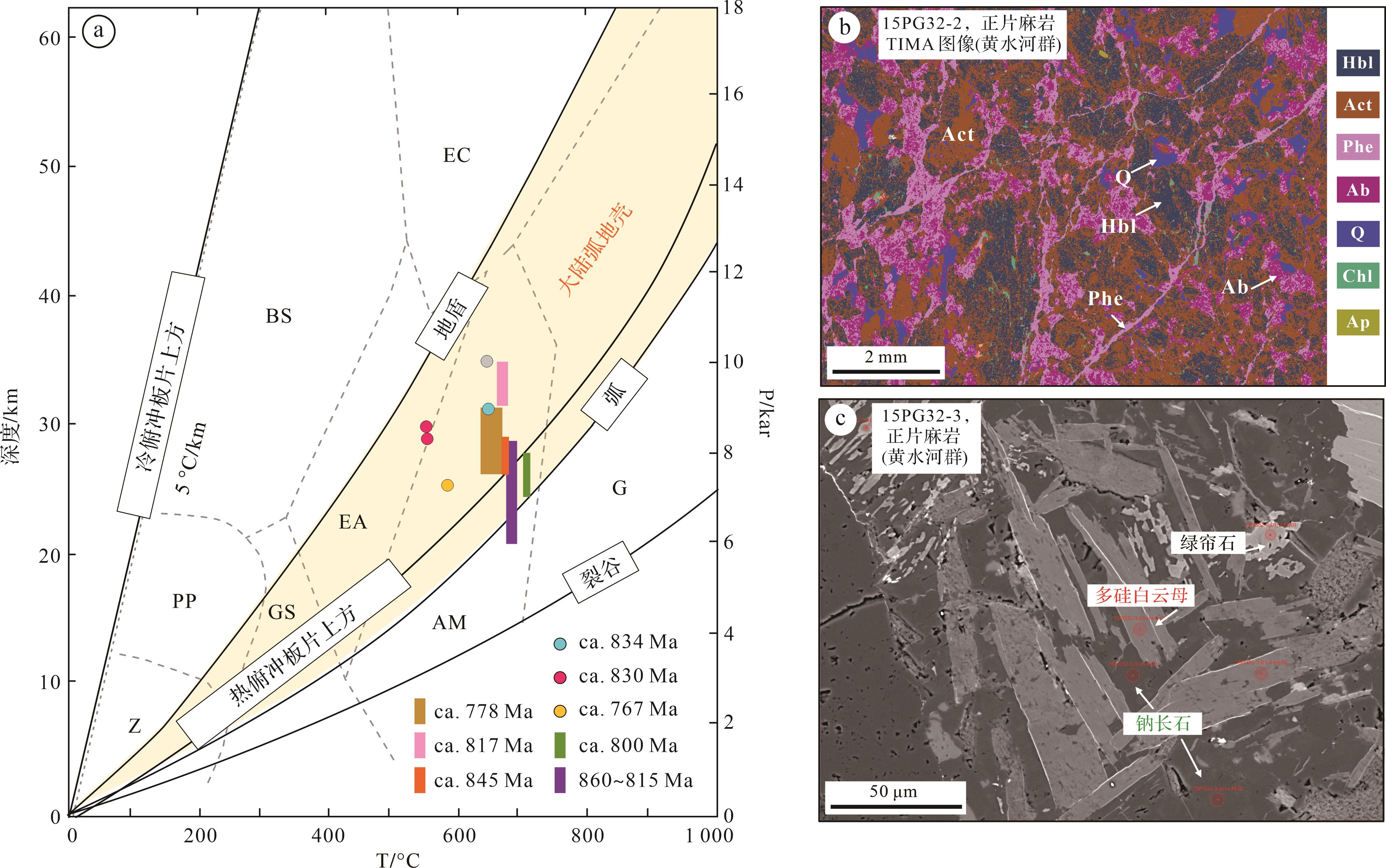|
[1]
|
Zhao G C, Cawood P A. Precambrian geology of China[J]. Precambrian Research, 2012, 222-223: 13-54. |
|
[2]
|
舒良树. 华南构造演化的基本特征[J]. 地质通报,2012,31(7):1035-1053.
Shu Liangshu. An analysis of principal features of tectonic evolution in South China Block[J]. Geological Bulletin of China, 2012, 31(7): 1035-1053. |
|
[3]
|
张国伟,郭安林,王岳军,等. 中国华南大陆构造与问题[J]. 中国科学:地球科学,2013,43(10):1553-1582.
Zhang Guowei, Guo Anlin, Wang Yuejun, et al. Tectonics of South China continent and its implications[J]. Science China: Earth Sciences, 2013, 43(10): 1553-1582. |
|
[4]
|
Shu L S, Yao J L, Wang B, et al. Neoproterozoic plate tectonic process and Phanerozoic geodynamic evolution of the South China Block[J]. Earth-Science Reviews, 2021, 216: 103596. |
|
[5]
|
Lin S F, Xing G F, Davis D W, et al. Appalachian-style multi-terrane Wilson cycle model for the assembly of South China[J]. Geology, 2018, 46(4): 319-322. |
|
[6]
|
Wang L J, Lin S F, Xiao W J. Yangtze and Cathaysia Blocks of South China: Their separate positions in Gondwana until Early Paleozoic juxtaposition[J]. Geology, 2023, 51(8): 723-727. |
|
[7]
|
Zhao J H, Yang T, Wang W. Orogenic belt resulting from ocean-continent collision[J]. Geology, 2022, 50(11): 1266-1269. |
|
[8]
|
舒良树,施央申,郭令智,等. 江南中段板块—地体构造与碰撞造山运动学[M]. 南京:南京大学出版社,1995:1-174.
Shu Liangshu, Shi Yangshen, Guo Lingzhi, et al. Plate tectonic evolution and the kinematics of collisional orogeny in the middle Jiangnan, eastaren China[M]. Nanjing: Nanjing University Press, 1995: 1-174. |
|
[9]
|
Wang X L, Zhou J C, Griffin W L, et al. Detrital zircon geochronology of Precambrian basement sequences in the Jiangnan orogen: Dating the assembly of the Yangtze and Cathaysia Blocks[J]. Precambrian Research, 2007, 159(1/2): 117-131. |
|
[10]
|
Wang X L, Zhou J C, Griffin W L, et al. Geochemical zonation across a Neoproterozoic orogenic belt: Isotopic evidence from granitoids and metasedimentary rocks of the Jiangnan orogen, China[J]. Precambrian Research, 2014, 242: 154-171. |
|
[11]
|
Zhao J H, Zhou M F, Yan D P, et al. Reappraisal of the ages of Neoproterozoic strata in South China: No connection with the Grenvillian orogeny[J]. Geology, 2011, 39(4): 299-302. |
|
[12]
|
Zhao G C. Jiangnan orogen in South China: Developing from divergent double subduction[J]. Gondwana Research, 2015, 27(3): 1173-1180. |
|
[13]
|
Yao J L, Cawood P A, Shu L S, et al. Jiangnan orogen, South China: A ~970-820 Ma Rodinia margin accretionary belt[J]. Earth-Science Reviews, 2019, 196: 102872. |
|
[14]
|
Xia Y, Xu X S, Niu Y L, et al. Neoproterozoic amalgamation between Yangtze and Cathaysia Blocks: The magmatism in various tectonic settings and continent-arc-continent collision[J]. Precambrian Research, 2018, 309: 56-87. |
|
[15]
|
Gao S, Ling W L, Qiu Y M, et al. Contrasting geochemical and Sm-Nd isotopic compositions of Archean metasediments from the Kongling high-grade terrain of the Yangtze Craton: Evidence for cratonic evolution and redistribution of REE during crustal anatexis[J]. Geochimica et Cosmochimica Acta, 1999, 63(13/14): 2071-2088. |
|
[16]
|
Zhang S B, Zheng Y F, Wu Y B, et al. Zircon U-Pb age and Hf-O isotope evidence for Paleoproterozoic metamorphic event in South China[J]. Precambrian Research, 2006, 151(3/4): 265-288. |
|
[17]
|
Yu J H, O’Reilly S Y, Zhou M F, et al. U-Pb geochronology and Hf-Nd isotopic geochemistry of the Badu complex, southeastern China: Implications for the Precambrian crustal evolution and paleogeography of the Cathaysia Block[J]. Precambrian Research, 2012, 222-223: 424-449. |
|
[18]
|
Wu Y B, Gao S, Zhang H F, et al. Geochemistry and zircon U-Pb geochronology of Paleoproterozoic arc related granitoid in the northwestern Yangtze Block and its geological implications[J]. Precambrian Research, 2012, 200-203: 26-37. |
|
[19]
|
Wang W, Zhou M F. Provenance and tectonic setting of the Paleo- to Mesoproterozoic Dongchuan Group in the southwestern Yangtze Block, South China: Implication for the breakup of the supercontinent Columbia[J]. Tectonophysics, 2014, 610: 110-127. |
|
[20]
|
Li J Y, Wang X L, Wang D, et al. Pre-Neoproterozoic continental growth of the Yangtze Block: From continental rifting to subduction-accretion[J]. Precambrian Research, 2021, 355: 106081. |
|
[21]
|
Yu J H, Cai Y F, Sun T, et al. Distribution and enrichment of rare metal elements in the basement rocks of South China: Controls on rare-metal mineralization[J]. Ore Geology Reviews, 2023, 163: 105797. |
|
[22]
|
于津海,魏震洋,王丽娟,等. 华夏地块:一个由古老物质组成的年轻陆块[J]. 高校地质学报,2006,12(4):440-447.
Yu Jinhai, Wei Zhenyang, Wang Lijuan, et al. Cathaysia Block: A young continent composed of ancient materials[J]. Geological Journal of China Universities, 2006, 12(4): 440-447. |
|
[23]
|
Yu J H, O’Reilly S Y, Wang L J, et al. Components and episodic growth of Precambrian crust in the Cathaysia Block, South China: Evidence from U–Pb ages and Hf isotopes of zircons in Neoproterozoic sediments[J]. Precambrian Research, 2010, 181(1/2/3/4): 97-114. |
|
[24]
|
Xu X S, O’Reilly S Y, Griffin W L, et al. The crust of Cathaysia: Age, assembly and reworking of two terranes[J]. Precambrian Research, 2007, 158(1/2): 51-78. |
|
[25]
|
Li T Z, Jiang M M, Zhao L, et al. Continental fragments in the South China Block: Constraints from crustal radial anisotropy[J]. Journal of Geophysical Research: Solid Earth, 2023, 128(10): e2023JB026998. |
|
[26]
|
Cawood P A, Wang W, Zhao T Y, et al. Deconstructing South China and consequences for reconstructing Nuna and Rodinia[J]. Earth-Science Reviews, 2020, 204: 103169. |
|
[27]
|
Condie K C, Bickford M E, R Cet al Aster. Episodic zircon ages, Hf isotopic composition, and the preservation rate of continental crust[J]. Geological Society of America Bulletin, 2011, 123(5/6): 951-957. |
|
[28]
|
Wang H Z, Oscar L, Zhang H F, et al. Recognition and significance of c. 800 Ma upper amphibolite to granulite facies metamorphism in metasedimentary rocks from the NW margin of the Yangtze Block[J]. Journal of the Geological Society, 2020, 177(2): 424-441. |
|
[29]
|
Li J Y, Tang M, Lee C T A, et al. Rapid endogenic rock recycling in magmatic arcs[J]. Nature Communications, 2021, 12(1): 3533. |
|
[30]
|
Li Z M G, Chen Y C, Zhang Q W L, et al. U-Pb dating of metamorphic monazite of the Neoproterozoic Kang-Dian orogenic belt, southwestern China[J]. Precambrian Research, 2021, 361: 106262. |
|
[31]
|
Li Z M G, Chen Y C, Zhang Q W L, et al. P-T conditions and timing of metamorphism of the Yuanmou area, southern Neoproterozoic Kang-Dian orogenic belt, southwest China[J]. Precambrian Research, 2022, 374: 106642. |
|
[32]
|
Zhu Y, Lai S C, Xie W L, et al. Wet calc-alkaline magmatic fractionation in the middle-upper crustal sections of the continental arc: Insights from the Neoproterozoic Nanba intrusive complex, western Yangtze Block, South China[J]. GSA Bulletin, 2024, 136(3/4): 928-948. |
|
[33]
|
He Y, Wu Y B, Zhao Y J, et al. Neoproterozoic amphibolite-facies metamorphism of the Douling complex in the northern Yangtze Craton and its tectonic implications: Constraints from petrology and zircon U-Pb-Hf-O isotopes[J]. Precambrian Research, 2023, 390: 107039. |
|
[34]
|
Zhang S B, Zheng Y F, Zhao Z F, et al. Neoproterozoic anatexis of Archean lithosphere: Geochemical evidence from felsic to mafic intrusions at Xiaofeng in the Yangtze gorge, South China[J]. Precambrian Research, 2008, 163(3/4): 210-238. |
|
[35]
|
Zhao J H, Zhou M F, Zheng J P, et al. Neoproterozoic tonalite and trondhjemite in the Huangling complex, South China: Crustal growth and reworking in a continental arc environment[J]. American Journal of Science, 2013, 313(6): 540-583. |
|
[36]
|
谷志东,张维,袁苗. 四川盆地威远地区基底花岗岩锆石SHRIMP U-Pb定年及其地质意义[J]. 地质科学,2014,49(1):202-213.
Gu Zhidong, Zhang Wei, Yuan Miao. Zircon SHRIMP U-Pb dating of basal granite and its geological significance in Weiyuan area of Sichuan Basin[J]. Chinese Journal of Geology, 2014, 49(1): 202-213. |
|
[37]
|
He D F, Li D, Li C X, et al. Neoproterozoic rifting in the Upper Yangtze continental block: Constraints from granites in the well W117 borehole, South China[J]. Scientific Reports, 2017, 7(1): 12542. |
|
[38]
|
Zheng Y F, Wu R X, Wu Y B, et al. Rift melting of juvenile arc-derived crust: Geochemical evidence from Neoproterozoic volcanic and granitic rocks in the Jiangnan orogen, South China[J]. Precambrian Research, 2008, 163(3/4): 351-383. |
|
[39]
|
Dong Y P, Hui B, Sun S S, et al. Neoproterozoic tectonic evolution and proto-basin of the Yangtze Block, China[J]. Earth-Science Reviews, 2024, 249: 104669. |
|
[40]
|
Li J Y, Wang X L, Cawood P A, et al. Neoproterozoic low-T/P metamorphism in the Yangtze Block manifests a long-lived subduction girdle around Rodinia[J]. Earth and Planetary Science Letters, 2024, 634: 118678. |
|
[41]
|
Sobolev S V, Brown M. Surface erosion events controlled the evolution of plate tectonics on Earth[J]. Nature, 2019, 570(7759): 52-57. |
|
[42]
|
Tang M, Chu X, Hao J H, et al. Orogenic quiescence in Earth’s middle age[J]. Science, 2021, 371(6530): 728-731. |
|
[43]
|
Spencer C J, Mitchell R N, Brown M. Enigmatic mid-Proterozoic orogens: Hot, thin, and low[J]. Geophysical Research Letters, 2021, 48(16): e2021GL093312. |
|
[44]
|
Cawood P A, Hawkesworth C J. Earth’s middle age[J]. Geology, 2014, 42(6): 503-506. |
|
[45]
|
Stern R J. The evolution of plate tectonics[J]. Philosophical Transactions of the Royal Society A: Mathematical, Physical and Engineering Sciences, 2018, 376(2132): 20170406. |
|
[46]
|
Stern R J. The Mesoproterozoic single-lid tectonic episode: Prelude to modern plate tectonics[J]. GSA Today, 2020, 30(12): 4-10. |
|
[47]
|
Brown M, Kirkland C L, Johnson T E. Evolution of geodynamics since the Archean: Significant change at the dawn of the Phanerozoic[J]. Geology, 2020, 48(5): 488-492. |
|
[48]
|
Cawood P A, Chowdhury P, Mulder J A, et al. Secular evolution of continents and the Earth system[J]. Reviews of Geophysics, 2022, 60(40): e2022RG000789. |
|
[49]
|
Li Z X, Bogdanova S V, Collins A S, et al. Assembly, configuration, and break-up history of Rodinia: A synthesis[J]. Precambrian Research, 2008, 160(1/2): 179-210. |
|
[50]
|
Cawood P A, Strachan R A, Pisarevsky S A, et al. Linking collisional and accretionary orogens during Rodinia assembly and breakup: Implications for models of supercontinent cycles[J]. Earth and Planetary Science Letters, 2016, 449: 118-126. |
|
[51]
|
Merdith A S, Collins A S, Williams S E, et al. A full-plate global reconstruction of the Neoproterozoic[J]. Gondwana Research, 2017, 50: 84-134. |
|
[52]
|
Wang C, Mitchell R N, Murphy J B, et al. The role of megacontinents in the supercontinent cycle[J]. Geology, 2021, 49(4): 402-406. |
|
[53]
|
Cawood P A, Martin E L, Murphy J B, et al. Gondwana’s interlinked peripheral orogens[J]. Earth and Planetary Science Letters, 2021, 568: 117057. |
|
[54]
|
Zhao J H, Pandit M K, Wang W, et al. Neoproterozoic tectonothermal evolution of NW India: Evidence from geochemistry and geochronology of granitoids[J]. Lithos, 2018, 316-317: 330-346. |
|
[55]
|
Ge R F, Zhu W B, Wilde S A, et al. Neoproterozoic to Paleozoic long-lived accretionary orogeny in the northern Tarim Craton[J]. Tectonics, 2014, 33(3): 302-329. |
|
[56]
|
Konopásek J, Janoušek V, Oyhantçabal P, et al. Did the circum-Rodinia subduction trigger the Neoproterozoic rifting along the Congo-Kalahari Craton margin?[J]. International Journal of Earth Sciences, 2018, 107(5): 1859-1894. |
|
[57]
|
Wang W, Cawood P A, Zhou M F, et al. Low‐δ18O rhyolites from the Malani igneous suite: A positive test for South China and NW India linkage in Rodinia[J]. Geophysical Research Letters, 2017, 44(20): 10298-10305. |
|
[58]
|
Peng M, Wu Y B, Wang J, et al. Paleoproterozoic mafic dyke from Kongling terrain in the Yangtze Craton and its implication[J]. Chinese Science Bulletin, 2009, 54(6): 1098-1104. |
|
[59]
|
An M J, Shi Y L. Lithospheric thickness of the Chinese continent[J]. Physics of the Earth and Planetary Interiors, 2006, 159(3/4): 257-266. |
|
[60]
|
Li M K, Song X D, Li J T, et al. Crust and upper mantle structure of East Asia from ambient noise and earthquake surface wave tomography[J]. Earthquake Science, 2022, 35(2): 71-92. |
|
[61]
|
Hu P Y, Zhai Q G, Wang J, et al. The Shimian ophiolite in the western Yangtze Block, SW China: Zircon SHRIMP U-Pb ages, geochemical and Hf-O isotopic characteristics, and tectonic implications[J]. Precambrian Research, 2017, 298: 107-122. |
|
[62]
|
Deng H, Peng S B, Polat A, et al. Neoproterozoic IAT intrusion into Mesoproterozoic MOR Miaowan ophiolite, Yangtze Craton: Evidence for evolving tectonic settings[J]. Precambrian Research, 2017, 289: 75-94. |
|
[63]
|
Wang X S, Gao J, Klemd R, et al. Early Neoproterozoic multiple arc–back-arc system formation during subduction–accretion processes between the Yangtze and Cathaysia Blocks: New constraints from the supra-subduction zone NE Jiangxi ophiolite (South China)[J]. Lithos, 2015, 236-237: 90-105. |
|
[64]
|
Zhang C L, Zou H B, Zhu Q B, et al. Late Mesoproterozoic to Early Neoproterozoic ridge subduction along southern margin of the Jiangnan orogen: New evidence from the northeastern Jiangxi ophiolite (NJO), South China[J]. Precambrian Research, 2015, 268: 1-15. |
|
[65]
|
李怀坤,田辉,周红英,等. 扬子克拉通北缘大洪山地区打鼓石群与神农架地区神农架群的对比:锆石SHRIMP U-Pb年龄及Hf同位素证据[J]. 地学前缘,2016,23(6):186-201.
Li Huaikun, Tian Hui, Zhou Hongying, et al. Correlation between the Dagushi Group in the Dahongshan area and the Shennongjia Group in the Shennongjia area on the northern margin of the Yangtze Craton: Constraints from zircon U-Pb ages and Lu-Hf isotopic systematics[J]. Earth Science Frontiers, 2016, 23(6): 186-201. |
|
[66]
|
Li L M, Lin S F, Xing G F, et al. Geochemistry and tectonic implications of Late Mesoproterozoic alkaline bimodal volcanic rocks from the Tieshajie Group in the southeastern Yangtze Block, South China[J]. Precambrian Research, 2013, 230: 179-192. |
|
[67]
|
Wang W, Zhao J H, Zhou M F, et al. Depositional age, provenance characteristics and tectonic setting of the Meso- and Neoproterozoic sequences in SE Yangtze Block, China: Implications on Proterozoic supercontinent reconstructions[J]. Precambrian Research, 2018, 309: 231-247. |
|
[68]
|
Wu P, Zhang S B, Zheng Y F, et al. Amalgamation of South China into Rodinia during the Grenvillian accretionary orogeny: Geochemical evidence from Early Neoproterozoic igneous rocks in the northern margin of the South China Block[J]. Precambrian Research, 2019, 321: 221-243. |
|
[69]
|
Shi Y R, Liu D Y, Zhang Z Q, et al. SHRIMP zircon U-Pb dating of gabbro and granite from the Huashan ophiolite, Qinling orogenic belt, China: Neoproterozoic suture on the northern margin of the Yangtze Craton[J]. Acta Geologica Sinica-English Edition, 2007, 81(2): 239-243. |
|
[70]
|
Li X H, Li W X, Li Z X, et al. Amalgamation between the Yangtze and Cathaysia Blocks in South China: Constraints from SHRIMP U–Pb zircon ages, geochemistry and Nd–Hf isotopes of the Shuangxiwu volcanic rocks[J]. Precambrian Research, 2009, 174(1/2): 117-128. |
|
[71]
|
Li J Y, Wang X L, Gu Z D. Early Neoproterozoic arc magmatism of the Tongmuliang Group on the northwestern margin of the Yangtze Block: Implications for Rodinia assembly[J]. Precambrian Research, 2018, 309: 181-197. |
|
[72]
|
Huang Y, Wang X L, Li J Y, et al. From arc accretion to within-plate extension: Geochronology and geochemistry of the Neoproterozoic magmatism on the northern margin of the Yangtze Block[J]. Precambrian Research, 2023, 395: 107133. |
|
[73]
|
Wu P, Zhang S B, Zheng Y F, et al. The accretion history of the South China Block at its northwest margin in the Neoproterozoic: Records from the Changba complex in the Mianlue zone[J]. Precambrian Research, 2021, 352: 106006. |
|
[74]
|
董云鹏,张国伟,赖绍聪,等. 随州花山蛇绿构造混杂岩的厘定及其大地构造意义[J]. 中国科学:地球科学,1999,29(3):222-231.
Dong Yunpeng, Zhang Guowei, Lai Shaocong, et al. Determination and their tectonic significance of Huashan ophiolitic mélange in Suizhou[J]. Science China: Earth Sciences, 1999, 29(3): 222-231. |
|
[75]
|
胡正祥,毛新武,田望学,等. 扬子陆块北缘大洪山地区发现晋宁期造山带[J]. 中国地质调查,2015,2(2):33-39.
Hu Zhengxiang, Mao Xinwu, Tian Wangxue, et al. Discovery of the Jinningian orogenic belt on the northern margin of Yangtze Craton in mountain Dahong[J]. Geological Survey of China, 2015, 2(2): 33-39. |
|
[76]
|
von Huene R, Scholl D W. Observations at convergent margins concerning sediment subduction, subduction erosion, and the growth of continental crust[J]. Reviews of Geophysics, 1991, 29(3): 279-316. |
|
[77]
|
Hacker B R, Kelemen P B, Behn M D. Differentiation of the continental crust by relamination[J]. Earth and Planetary Science Letters, 2011, 307(3/4): 501-516. |
|
[78]
|
Sauer K B, Gordon S M, Miller R B, et al. Transfer of metasupracrustal rocks to midcrustal depths in the North Cascades continental magmatic arc, Skagit gneiss complex, Washington[J]. Tectonics, 2017, 36(12): 3254-3276. |
|
[79]
|
Ducea M N, Chapman A D. Sub-magmatic arc underplating by trench and forearc materials in shallow subduction systems; A geologic perspective and implications[J]. Earth-Science Reviews, 2018, 185: 763-779. |
|
[80]
|
Isozaki Y. Anatomy and genesis of a subduction-related orogen: A new view of geotectonic subdivision and evolution of the Japanese islands[J]. Island Arc, 1996, 5(3): 289-320. |
|
[81]
|
Foster D A, Gray D R. Evolution and structure of the Lachlan fold belt (orogen) of eastern Australia[J]. Annual Review of Earth and Planetary Sciences, 2000, 28: 47-80. |
|
[82]
|
DeCelles P G, Ducea M N, Kapp P, et al. Cyclicity in Cordilleran orogenic systems[J]. Nature Geoscience, 2009, 2(4): 251-257. |
|
[83]
|
张泽明,丁慧霞,董昕,等. 俯冲带变质作用与构造机制[J]. 岩石学报,2021,37(11):3377-3398.
Zhang Zeming, Ding Huixia, Dong, Xin, et al. Metamorphism and tectonic mechanisms of subduction zones[J]. Acta Petrologica Sinica, 2021, 37(11): 3377-3398. |
|
[84]
|
舒良树,周围庆,施央申,等. 江南造山带东段高压变质蓝片岩及其地质时代研究[J]. 科学通报,1993,38(20):1879-1882.
Shu Liangshu, Zhou Weiqing, Shi Yangshen, et al. High-pressure metamorphic blueschist within the eastern Jiangnan orogen and its formation age[J]. Chinese Science Bulletin, 1993, 38(20): 1879-1882. |
|
[85]
|
Yang Z, Cawood P A, Zi J W, et al. Mid-Neoproterozoic (ca. 845 Ma) metamorphism of the southwestern Yangtze Block and its tectonic implications[J]. Precambrian Research, 2024, 400: 107267. |
|
[86]
|
Cawood P A, Kröner A, Collins W J, et al. Accretionary orogens through Earth history[J]. Geological Society, London, Special Publications, 2009, 318(1): 1-36. |
|
[87]
|
王孝磊,周金城,陈昕,等. 江南造山带的形成与演化[J]. 矿物岩石地球化学通报,2017,36(5):714-735.
Wang Xiaolei, Zhou Jincheng, Chen Xin, et al. Formation and evolution of the Jiangnan orogen[J]. Bulletin of Mineralogy, Petrology and Geochemistry, 2017, 36(5): 714-735. |
|
[88]
|
Wang X L, Zhou J C, Wan Y S, et al. Magmatic evolution and crustal recycling for Neoproterozoic strongly peraluminous granitoids from southern China: Hf and O isotopes in zircon[J]. Earth and Planetary Science Letters, 2013, 366: 71-82. |
|
[89]
|
Li J Y, Wang X L, Gu Z D. Petrogenesis of the Jiaoziding granitoids and associated basaltic porphyries: Implications for extensive Early Neoproterozoic arc magmatism in western Yangtze Block[J]. Lithos, 2018, 296-299: 547-562. |
|
[90]
|
Huang Y, Wang X L, Li J Y, et al. Early Neoproterozoic tectonic evolution of northern Yangtze Block: Insights from sedimentary sequences from the Dahongshan area[J]. Precambrian Research, 2021, 365: 106382. |
|
[91]
|
Matthews A, Schliestedt M. Evolution of the blueschist and greenschist facies rocks of Sifnos, Cyclades, Greece. A stable isotope study of subduction-related metamorphism[J]. Contributions to Mineralogy and Petrology, 1984, 88(1/2): 150-163. |
|
[92]
|
Avigad D. Tectonic juxtaposition of blueschists and greenschists in Sifnos Island (Aegean Sea):Implications for the structure of the Cycladic blueschist belt[J]. Journal of Structural Geology, 1993, 15(12): 1459-1469. |
|
[93]
|
Bang Y, Hwang H, Kim T, et al. The stability of subducted glaucophane with the Earth’s secular cooling[J]. Nature Communications, 2021, 12(1): 1496. |
|
[94]
|
Pirajno F. A classification of mineral systems, overviews of plate tectonic margins and examples of ore deposits associated with convergent margins[J]. Gondwana Research, 2016, 33: 44-62. |
|
[95]
|
郑永飞,陈伊翔,陈仁旭,等. 汇聚板块边缘构造演化及其地质效应[J]. 中国科学:地球科学,2022,52(7):1213-1242.
Zheng Yongfei, Chen Yixiang, Chen Renxu, et al. Tectonic evolution of convergent plate margins and its geological effects[J]. Science China: Earth Sciences, 2022, 52(7): 1213-1242. |
|
[96]
|
Wang G G, Ni P, Yao J, et al. The link between subduction-modified lithosphere and the giant Dexing porphyry copper deposit, South China: Constraints from high-Mg adakitic rocks[J]. Ore Geology Reviews, 2015, 67: 109-126. |
|
[97]
|
郭令智,施央申,马瑞士,等. 中国东南部地体构造的研究[J]. 南京大学学报(自然科学版),1984,20(4):732-739.
Guo Lingzhi, Shi Yangshen, Ma Ruishi, et al. Tectonostratigraphic terranes of southeast China[J]. Journal of Nanjing University (Natural Sciences Edition), 1984, 20(4): 732-739. |
|
[98]
|
Zhang Z Y, Hou Z Q, Lü Q T, et al. Crustal architectural controls on critical metal ore systems in South China based on Hf isotopic mapping[J]. Geology, 2023, 51(8): 738-742. |
|
[99]
|
Hou Z Q, Pan X F, Li Q Y, et al. The giant Dexing porphyry Cu-Mo-Au deposit in East China: Product of melting of juvenile lower crust in an intracontinental setting[J]. Mineralium Deposita, 2013, 48(8): 1019-1045. |
|
[100]
|
向路. 江南造山带西缘新元古代锡铌钽成矿作用[D]. 南京:南京大学,2020:1-199.
Xiang Lu. Neoproterozoic tin-niobium-tantalum metallogenesis in the western part of Jiangnan orogen[D]. Nanjing: Nanjing University, 2020: 1-199. |



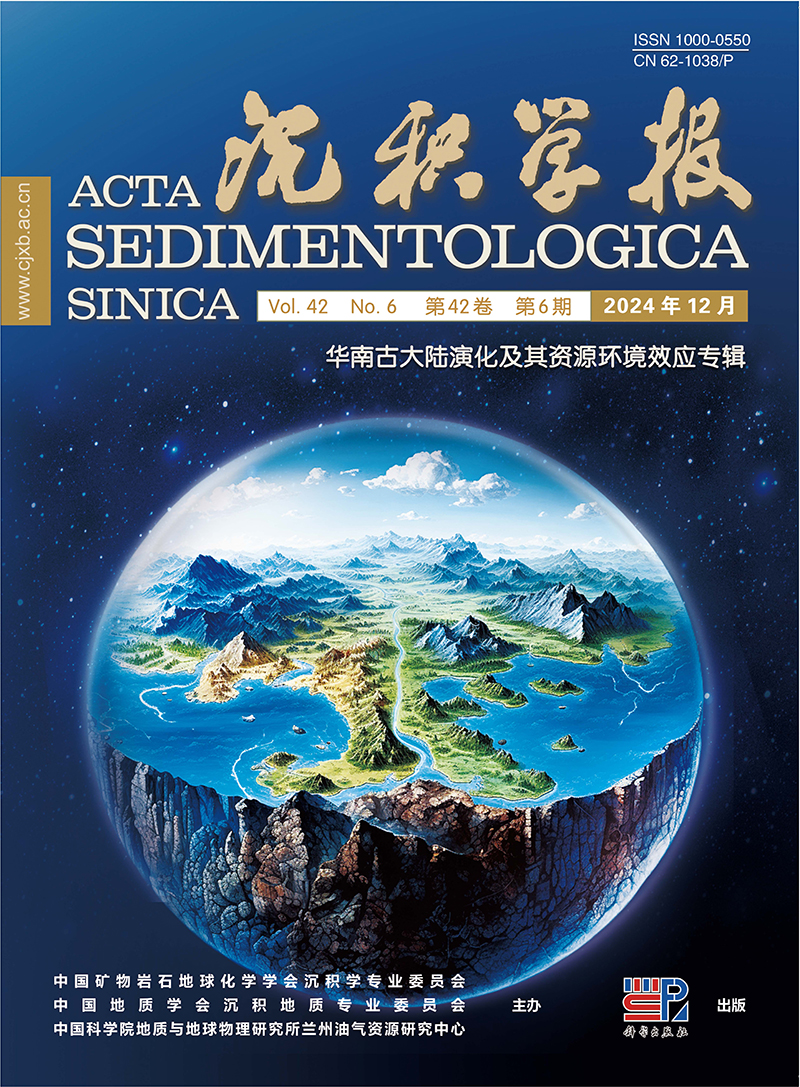








 DownLoad:
DownLoad:
